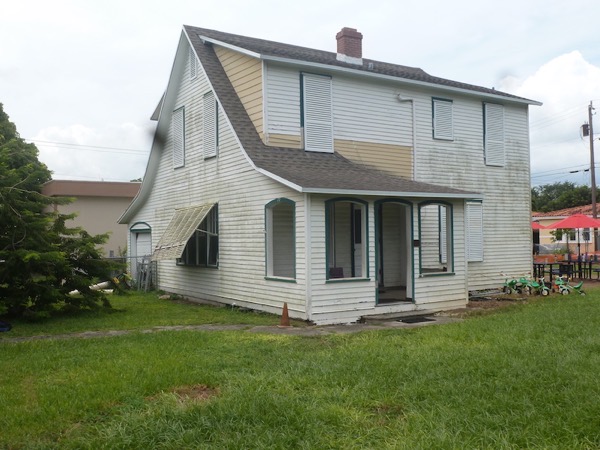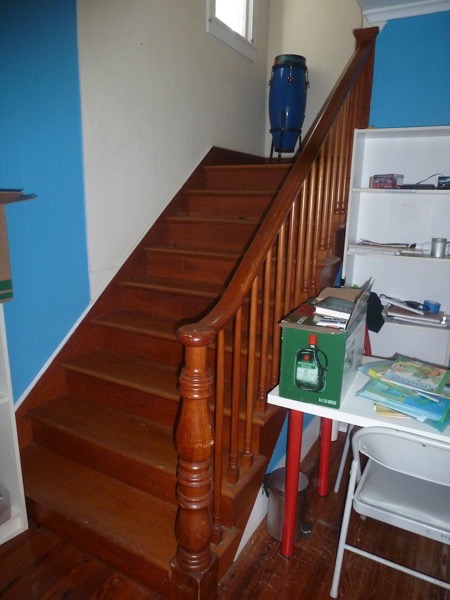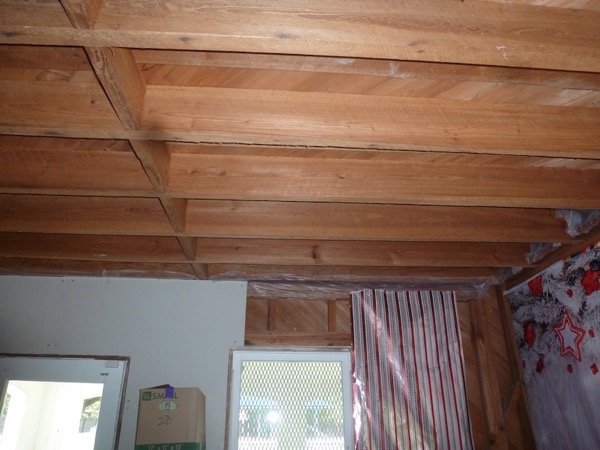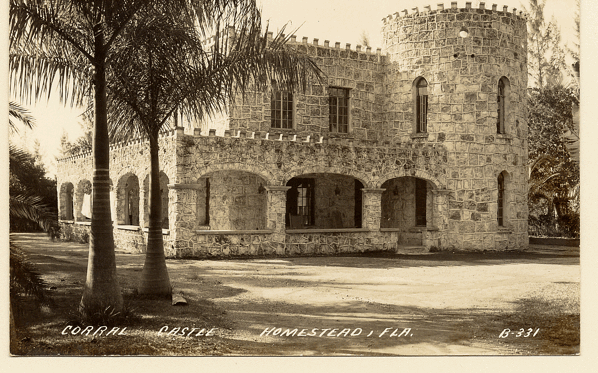The House That McNeill Built
by Jeff Blakley
If you turn west on NW 6th St. from Krome Avenue, you will see a two-story New England style house on the right, at 77 NW 6th St. It is an unusual house for Homestead, with its steep roof line. I’ve long been curious about it and only knew it as the McNeill house but knew nothing about who built it or its significance. It turns out that it was the home of Mary S. McNeill, the daughter of Joseph Abraham and Sarah Nixon McNeil. Mary was a church historian who wrote a history of the First United Methodist Church of Homestead in 1974.
Joseph McNeill built the house in 19381 after coming here from the Isle of Pines in Cuba in 1925.2 The family first lived at 26 NW 6th St. in a house that was demolished by the Community Bank of Homestead, which built a branch office there.3 The First United Methodist Church of Homestead, which owns the historic house, would like to find a person with the money, an interest in history and a vacant lot to move the house to. The Church is very interested in the history of Homestead and really does not want to have the house demolished.

The house has not been designated as a historic property by the City of Homestead’s Historic Preservation Board, so that makes it easier to move the house. While moving a house, particularly a two-story house, is quite a project, it can be done. The exterior sheathing is not in good condition, but the bones of the house are in excellent condition. The lumber, which is rough sawn and full-dimensional is probably not Dade County pine, as the house was built in 1938, after most of the native timber had already been cut. The floors are pine and there is a beautiful wooden staircase leading to the second floor. The house also has a fireplace on the first floor.
If anyone is interested, please reach out to the Church office at 305-248-4770. Because the house needs to be moved, the price will be nominal.
Joseph Abraham McNeill was born in Canada to Scottish parents on December 4, 1869.4 As a young man, he moved to Buffalo, NY5 6 where he worked as a carpenter.7 While there, he may have made the acquaintance of his future wife, Sarah Nixon, the daughter of William and Sophia Nixon, all of whom were born in England. Nixon also owned a farm on the Isle of Pines.8 On November 5, 1911, Joseph married Sarah Nixon at Nueva Gerona, Isle of Pines, Cuba.9 Her parents were enumerated in Buffalo, NY in the 1900 census. William was apparently well-to-do, as his occupation given on the census of that year was as a “radiator manufacturer.” Two of his daughters were bookkeepers in medical offices, his son John was a woodworker at a carriage builder and his son Frank was a wallpaper dealer. William was not enumerated in Buffalo in 1910, likely because he was on his farm in the Isle of Pines.
Joseph acquired land on the Isle of Pines, now known as the Isle of Youth, likely in the town of McKinley from the Tropical Development Company of Buffalo.10 He and Adam Gaiser, another resident of Buffalo, sailed for the Isle of Pines in early January, 190511 on board the Morro Castle.12 American settlement on the island started shortly after the Treaty of Paris ended the Spanish-American War in 1900.13 Joseph, along with 10 others, wrote glowing testimonials about their new home for the Tropical Development Co.14 The hundreds of other Americans who moved there grew oranges, grapefruit, mangos, tobacco and pineapples and other crops. The residents on the Isle of Pines came from every state in the Union, but the majority were from Nebraska, Kansas, Pennsylvania, New York and Florida.15 According to the Buffalo Morning Express, in 1902 Americans owned half of the land on the island and were the majority of the tax-payers.16
There are conflicting reports of what J. A. McNeill did while he was living on the Isle of Pines. One account states that he was a “superintendent of construction on the Isle of Pines for the Cuban government”17 while another states that he “purchased 120 acres on the Isle of Pines at the current rate of $25 an acre…”18 He may have done both. For those interested in the complex issues that played out on the Isle of Pines between 1904 and 1925, Samuel Finesurry’s review of Michael E. Neagle’s book, American’s Forgotten Colony: Cuba’s Isle of Pines, is an excellent starting point. Whatever work J. A. McNeill engaged in during his time on the Isle of Pines, by the time the Hay-Quesada Treaty was ratified by United States on March 13, 1925, he had had enough and decided to return to the United States.
J. A. and Sarah’s only child, Mary Sophia, was born on the Isle of Pines on October 10, 1914. She and her parents arrived in Key West on March 25, 1925 on board the S. S. Governor Cobb,19 a steamship that was leased to the P & O Steamship Co., a Flagler company, during the winter season when it made daily runs to Havana.20 Why the family settled in Homestead is unknown but they likely had friends who lived here. Dan Roberts‘ brother, George D. Roberts, lived on the Isle of Pines and when he died in 1961, was buried in the American Cemetery in Nueva Gerona. Dan sold a large number of the Isle of Pines variety of grapefruit trees in his nursery. Joseph and Sarah first lived in a house at 26 NW 6th St.21 and then, in 1938, J. A. built the house at 77 NW 6th St., where he lived until he died in 1969.


After arriving here, J. A. established himself as a carpenter and his wife and daughter got involved with the Ladies Aid Society at the White Stone Methodist Church, at N.W. 1st Ave. and 4th St. The first mention of them attending a social function of the Society appeared in the Homestead Leader on September 9, 1926, shortly before the hurricane that is known as the “1926 Miami Hurricane” hit South Dade on the 18th. The center of that hurricane, contrary to popular belief, passed over Perrine, not Miami, and destroyed crops and groves all over South Dade. No doubt, the Ladies Aid Society provided aid to those affected by the storm in the Homestead area. Those attending that social function were the Mesdames Tupper, McNeill, J. W. Avery, H. H. Ewing, Geo. Fuller, M. J. Deyo, Newton G. Ball, I. S. Showalter, J. T. Cann, A. J. Ennis, Dibble and the Misses McNeill and Priscilla Cann. A meeting on December 2 added the names of Mesdames E. A. Ennis, Geo. Ranson, Fred Prussner, Ernest Carter and the Misses Mary Sifling and Viola Prussner.
J. A. McNeill designed and supervised the construction of what is now known as the Cloninger Castle, at 31500 S.W. 187th Ave. It was built in 1929 for Reuben Pearse Walker, a retired monument manufacturer from Wilkes-Barre, PA. The house was 51 feet by 44 feet, including a 10-foot wide veranda which encircled the first floor. Construction was of native rock, backed by poured concrete walls, with steel doors and windows. The house had 4 bedrooms, a dining room, breakfast room, kitchen and bathroom. The tower, 18′ in diameter and 26′ tall, included part of the living room on the 1st floor and parts of the bedrooms on the 2nd floor.22 The stonework was done by Vannie L. Harris, Sr.23 whose grandson, Jim, owner of Harris & Schroeder Builders, builds custom homes in the Homestead area. McNeill built “many of the best homes”24 in Homestead, though they have not been identified. The house, which was damaged by Hurricane Andrew in 1992, sits roofless and windowless, likely because the owner, who is from Venezuela, has elected not to restore it because dealing with the City of Homestead and Miami-Dade County is too difficult.

Mary S. McNeill graduated from Homestead High School on May 26, 1933. The graduates were: Burton Branch, Wilbur Free, Charles Glenn, Wm. Henn, Edward Little, James Roberts, Lester Smith, Augustus Wynn, Mary Akers, Ella Arozarena, Estelle Booth, Nellie Gooding, Flossie Gorday, Rubie Lee Groover, Amy Horne, Margaret Hendricks, Ingeborg Mattson, Mary McNeill, Evelyn Smith, Ruth Steffani, Anna Steffani, Eva Sullivan, Julia Sullivan and Rae Woodbury.
In 1955, Mary was the head bookkeeper at Brooker Lumber.25 Mary was active in the Methodist Church all of her life but I didn’t do much research on her as this article is about the house that her father built. Perhaps readers will contribute their memories of Mary for others to read.
In 1959, at the age of 90, J. A. McNeill was photographed by Maitland Davidson on a ladder painting the second floor of his house.26 Mary’s mother died in 1965 and her father in 1969, 6 days after his 100th birthday. Mary passed away in 2011 at the age of 96 and is fondly remembered by many members of the congregation of the First United Methodist Church of Homestead and doubtless by many others who no longer live in Homestead. She sold her house, built by her father, to the Church to pay for her health care in her later years. If you know someone who might be interested in buying and moving it, please have them call the Church office at 305-248-4770.
___________________________________________________________________
- The Miami-Dade County Property Appraiser’s website gives the year as 1928 but an article in the Homestead Leader – Perrine Post on December 3, 1959, p. 1 states that the house was built in 1938.
- Homestead Leader-Perrine Post, December 3, 1959, p. 1
- Sarah McNeill’s Petition for Naturalization
- ibid.
- Homestead Leader-Perrine Post, December 3, 1959, p. 1
- In 1905, he lived at 241 Vermont St. This was in The Buffalo Evening News issue of February 21, 1905 on page 7
- Homestead Leader Perrine-Post, December 3, 1959, p. 1
- ibid.
- Sarah McNeill’s Petition for Naturalization
- Buffalo Evening News, February 21, 1905, p. 7
- The Buffalo Times, January 8, 1905, p. 26
- Homestead Leader – Perrine Post, December 3, 1959, p. 1
- Buffalo Evening News, February 21, 1905, p. 7
- ibid.
- Keyword search on “Isle of Pines” at newspapers.com for the period 1902 – 1925
- Buffalo Morning Express, Nov. 11, 1902, p. 2
- Homestead Leader, June 20, 1929, p. 1
- Homestead Leader – Perrine Post, December 3, 1959, p. 26
- Sarah McNeill’s Petition for Naturalization
- https://en.wikipedia.org/wiki/SS_Governor_Cobb
- Sarah McNeill’s Petition for Naturalization
- Homestead Leader, June 20, 1929, p. 1
- Homestead Leader – Perrine Post, December 3, 1959, p. 1
- ibid.
- Polk’s 1955 Directory of Homestead
- Homestead Leader – Perrine Post, December 3, 1959, p. 1

Thank you, Jeff. Interesting and well done! You are doing important work! Press on!
“A nation which does not remember what it was yesterday does not know what it is today, or what it is trying to do.” ~ General R. E. Lee
You’ve done it again Jeff! This is such good research and the City should take an interest in these articles and in the preservation of its historic built environment. My mother, Evelyn Smith, and her brother, Lester were in that 1933 class at Homestead High School. I knew Miss McNeil as a Sunday school teacher and regular fixture at the Methodist Church.
Thanks, Jeff, for another great and interesting article. It is sad that I lived in Homestead for so long and never even thought about many of the things that you research and publish. I find them very interesting now and look forward to the next one.
Great to see you back Jeff. Nice article and great research. I hope you will keep digging and sharing. I agree with Susan’s comments. Many thanks. Ed
Great article, Jeff!
Thanks, Jeff, very interesting article, especially the connections to Isle of Pines, Cuba.
Good show Jeff! Immensely interesting.
Thank you, Jeff, for this very informative article. Brought me back home quickly. Remember Miss Mary from church every Sunday and from Brooker Lumber Co. My father W. B. Mills was also a bookkeeper at Brooker’s. My mother Margaret Mills was a teacher at Neva King Elementary. My teacher in the second grade.😊 Have wonderful memories of growing up in Homestead. Would love to go back to the 50’s & 60’s!
Best wishes to continue the history hunt,
Anna Margaret Mills Peele
Hi Anna,
Was your mother the Margaret in the Margaret Mills Music Club?
Yes she was.
Please contact me via email – [email protected].
The Cloninger Castle/Pearse Walker home is one of my favorite structures ever. I have taken quite a few photos there, both that I shot or that have me in them!. Just yesterday I wrote a ‘script’ for a promotional video of the area and mentioned that building. I love the McNeill house too, and coincidentally I used to own the McClure house at 1260 NW 9th Street right off of 187th & Campbell Drive. I miss it…
I know of a McClure house at 18470 SW 296 St. but I was not aware of the house you mentioned. What was the full name of the McClure who built the house? The house I mentioned is also known as the McClure/Ballard home.
When we moved back to Homestead after college graduation (1968), we lived at 17250 SW 296th street, in the middle of an avocado grove owned by the Caves family.
You wouldn’t happen to have a photograph of the house, would you? I’d love to have a copy of it for my files.
You won’t be surprised that the avocado grove is gone and the property has been subdivided into building lots with very expensive houses on them. The property belonged to Albert R. Caves and his wife, Carrie Johnston Caves. She was the daughter of H. Wallace Johnston and his wife, Rose Phillips, who owned Tropical Lodge.
Hi Jeff,
Great to hear from you again. I learn so much from your articles.
Hello Jeff,
Pearse Walker was my great uncle. My mother spoke of her uncle leaving Canada and settling in Homestead, but I had no idea about the history of his house.
Thank you for this information about Coral Castle.